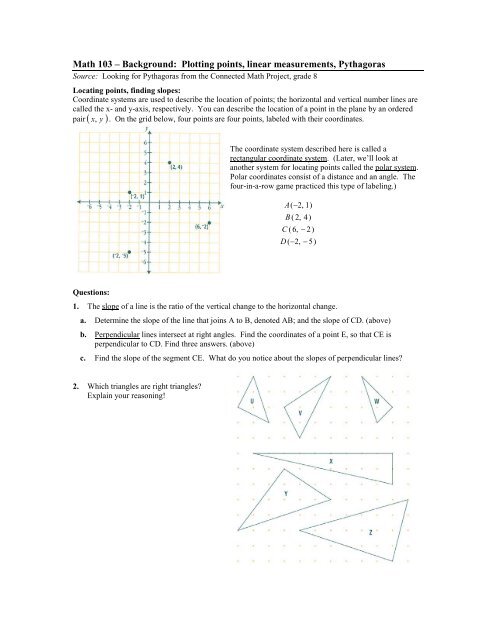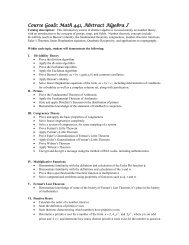Source: Looking for Pythagoras from the Connected Math Project ...
Source: Looking for Pythagoras from the Connected Math Project ...
Source: Looking for Pythagoras from the Connected Math Project ...
You also want an ePaper? Increase the reach of your titles
YUMPU automatically turns print PDFs into web optimized ePapers that Google loves.
<strong>Math</strong> 103 – Background: Plotting points, linear measurements, <strong>Pythagoras</strong><br />
<strong>Source</strong>: <strong>Looking</strong> <strong>for</strong> <strong>Pythagoras</strong> <strong>from</strong> <strong>the</strong> <strong>Connected</strong> <strong>Math</strong> <strong>Project</strong>, grade 8<br />
Locating points, finding slopes:<br />
Coordinate systems are used to describe <strong>the</strong> location of points; <strong>the</strong> horizontal and vertical number lines are<br />
called <strong>the</strong> x- and y-axis, respectively. You can describe <strong>the</strong> location of a point in <strong>the</strong> plane by an ordered<br />
x, y . On <strong>the</strong> grid below, four points are four points, labeled with <strong>the</strong>ir coordinates.<br />
pair ( )<br />
Questions:<br />
The coordinate system described here is called a<br />
rectangular coordinate system. (Later, we’ll look at<br />
ano<strong>the</strong>r system <strong>for</strong> locating points called <strong>the</strong> polar system.<br />
Polar coordinates consist of a distance and an angle. The<br />
four-in-a-row game practiced this type of labeling.)<br />
A(<br />
−2,<br />
1)<br />
B ( 2,<br />
4)<br />
C ( 6,<br />
− 2)<br />
D ( −2,<br />
− 5)<br />
1. The slope of a line is <strong>the</strong> ratio of <strong>the</strong> vertical change to <strong>the</strong> horizontal change.<br />
a. Determine <strong>the</strong> slope of <strong>the</strong> line that joins A to B, denoted AB; and <strong>the</strong> slope of CD. (above)<br />
b. Perpendicular lines intersect at right angles. Find <strong>the</strong> coordinates of a point E, so that CE is<br />
perpendicular to CD. Find three answers. (above)<br />
c. Find <strong>the</strong> slope of <strong>the</strong> segment CE. What do you notice about <strong>the</strong> slopes of perpendicular lines?<br />
2. Which triangles are right triangles?<br />
Explain your reasoning!
3. The points ( 0 , 0 ) and ( , 2 )<br />
3 are two vertices of a polygon.<br />
a. If <strong>the</strong> polygon is square, find <strong>the</strong> o<strong>the</strong>r two vertices. (There are two squares that answer this<br />
question, find both.)<br />
b. If <strong>the</strong> polygon is a nonrectangular parallelogram, what might <strong>the</strong> o<strong>the</strong>r two vertices be? (Infinitely<br />
many answers are possible.)<br />
c. If <strong>the</strong> polygon is a right triangle, what might <strong>the</strong> o<strong>the</strong>r vertex be? Find two. (Infinitely many<br />
answers are possible.)<br />
d. The points ( 3 , 3 ) and ( , 6 )<br />
2 are two vertices of a right triangle. List at least three points that<br />
could be <strong>the</strong> o<strong>the</strong>r vertex.<br />
4. On grid paper, draw several parallelograms with diagonals that are perpendicular. What do you<br />
observe about <strong>the</strong>se parallelograms?<br />
Finding area and lengths:<br />
1. Find <strong>the</strong> area of each figure below. Consider <strong>the</strong> horizontal or vertical distance between adjacent dots<br />
to be one unit. (Curriculum addition: Describe <strong>the</strong> strategy that you used.)
2. The smallest square you can draw by connecting dots on a five-by-five dot grid is a 1-by-1 unit square,<br />
which has area one square unit, as shown. You can also draw a 2-by-2, which has area 4 square units,<br />
as well as o<strong>the</strong>r larger square. These square are called upright. You can also draw tilted squares, like<br />
last one shown. This square has area 2. Explain why this square has area 2.<br />
3. On <strong>the</strong> grid paper below, find as many upright and as many tilted squares that can be drawn on a fiveby-five<br />
grid by connecting dots. Write <strong>the</strong> area of each square inside <strong>the</strong> square. Be sure you can<br />
explain how you can be sure that each tilted square you drew really is square.
Intro to square roots: The area of a square is <strong>the</strong> length of a side multiplied by itself. This can be<br />
2<br />
expressed by <strong>the</strong> <strong>for</strong>mula A = s × s or A = s . If you know <strong>the</strong> area of a square, you can work backwards<br />
to find <strong>the</strong> length of a side. For example, if a square has area 4 square units, <strong>the</strong>n <strong>the</strong> length of a side is 2 –<br />
we call 2 a square root of 4 and write this 2 = 4 . If a square has area 2 square units, we call <strong>the</strong> length of<br />
a side 2 . To find <strong>the</strong> length of a line segment which is not vertical or horizontal, we could use areas of<br />
squares like this:<br />
4. Express <strong>the</strong> length of <strong>the</strong> side of each tilted square that you found in problem 3 above, using<br />
notation.<br />
5. Express <strong>the</strong> length of <strong>the</strong> segment shown using<br />
numbers is this length?<br />
notation. Between what two consecutive whole<br />
Pythagorean Theorem:<br />
Consider a right triangle with legs as shown.<br />
1. How are <strong>the</strong> areas of <strong>the</strong> attached squares related?<br />
2. Construct line segments by connecting dots on <strong>the</strong> attached grid paper of <strong>the</strong> following lengths:<br />
a. 13 b. 17 c. 20 d. 34



